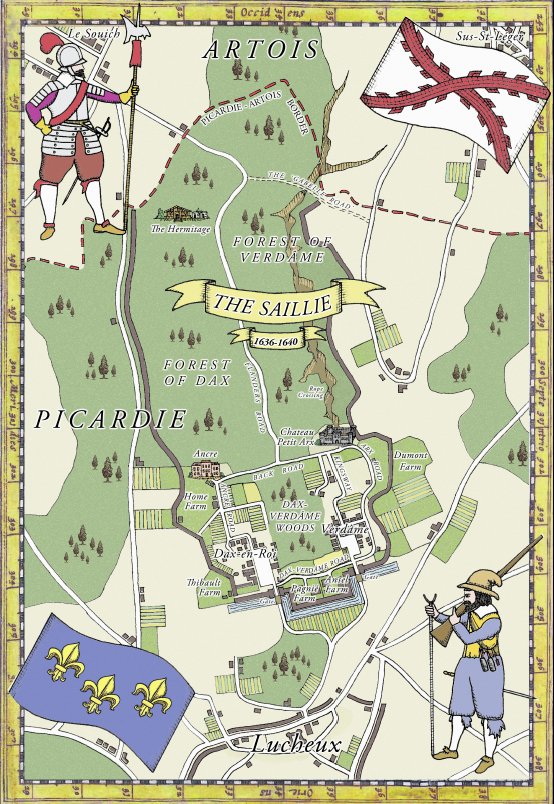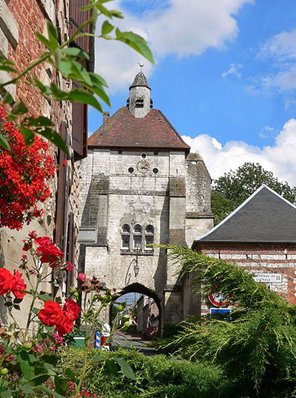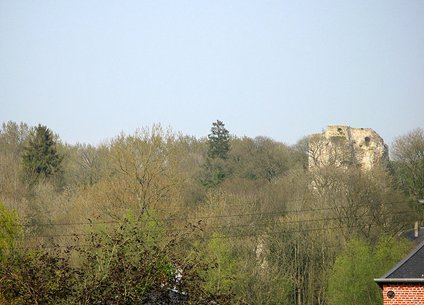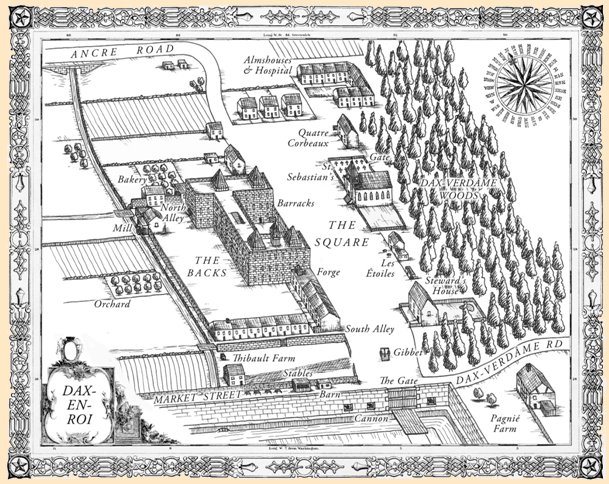![]()
The Saillie comprises the two villages of Dax-en-roi and Verdâme, and is set roughly in the stretch of land at that time covered by the Forest of Lucheux in Picardy, right on the old Picardy/Artois border.
‘Saillie’ is a French word for ‘projection’ and the Forest of Lucheux does indeed stick like an aggressive finger into the territory of neighbouring Artois. This matters little today, but in 1636 Artois was part of the Spanish Netherlands, and the Spaniards would naturally have been eager to absorb this intruding splinter of France to strengthen their own border. As Père Gérard tells us, the Wall about the villages was originally built to protect Artois from France rather than vice-versa - and if the Spaniards had their way it would do so again.
Much of the area is still forested to this day, as the Google satellite image shows.
The number of fields in the image reflects the highly agricultural nature of the area, which is also outstandingly beautiful. This picture by JeanPierre Fayeulle shows the glorious colours of the region, as well as the density of the trees in which our characters succeed in hiding for so long.

© JeanPierre Fayeulle, Spring is Beautiful
This map of the Saillie shows how it fits loosely into the area north of Lucheux:

The majority of the farmland inevitably falls outside the ‘town’ wall, and is (as Colin tells us) a significant reason for the food shortages inside the Saillie during the Occupation. Without the money to buy food from neighbouring Artois, the inhabitants simply could not have survived.
Town walls, often with moats, were still common in the mid 17th century, and were even found round villages. The village of Saint-Jean-aux-Bois in the Forest of Compiègne, for instance still retains many features of its old fortifications, which are of much more impressive construction than those around the Saillie.
Lucheux itself was still walled at that time, and some of its mediaeval fortifications can still be seen today. The famous belfry is set above one of the original town gates, which also demonstrates the thickness of the walls:

Unfortunately the old donjon referred to by Jacques is now largely in ruins, and the Forest seems to be swallowing more of it every day:

For obvious reasons there are no photographs of the Saillie itself, but here at least is a plan of the centre of Dax, which might help clarify the chase in chapter 11, the route from the barracks in chapter 23, and of course the Battle itself.

Père Gérard, the curé of Dax, was clearly tediously proud of the Saillie, and extolled its virtues at some length in his André de Roland: A Personal Memoir. I have quoted a section of his description in the manuscripts of Honour and the Sword, but for those interested in social and economic detail there is a great deal more.
Visitors have sometimes lamented the waste of land where so much is given over to the rising slopes of trees, yet in truth this forest adds much to our prosperity. Its wood gives us the materials for our houses, its fringes provide occupation for our carpenters and charcoal burners, its trees yield a quantity of acorns for the fattening of our pigs, and its vast resources of wild animal life, including deer and boar, present miles of hunting ground to rival even the famous forest of Compiègne.
The populated areas of the villages themselves are also thriving. The cens is fixed low and we tithe at only seven percent, for our church of St Sebastian was endowed by the Seigneur himself, and a very small stipend suffices my own humble needs. We are particularly favoured in Dax, with three major farms and a quantity of individual smallholdings, which produce all the cereal for our needs, as well as the barley and hops for our excellent local beer. Grapes do not grow well here, and our wine is in little demand outside the Saillie, but our cider is famous throughout the province and beyond.
And here is Jacques on the same subject:
Our wine’s always been crap. You don't get good grapes in Picardie, they start off mean and hard then go all baggy and soft without the good stage in between when they taste nice. We still drank it, though, especially my father, I mean you've got to have wine. It made good vinegar too.
Thanks to Stuart James, who drew the maps of the Saillie and the centre of Dax.
